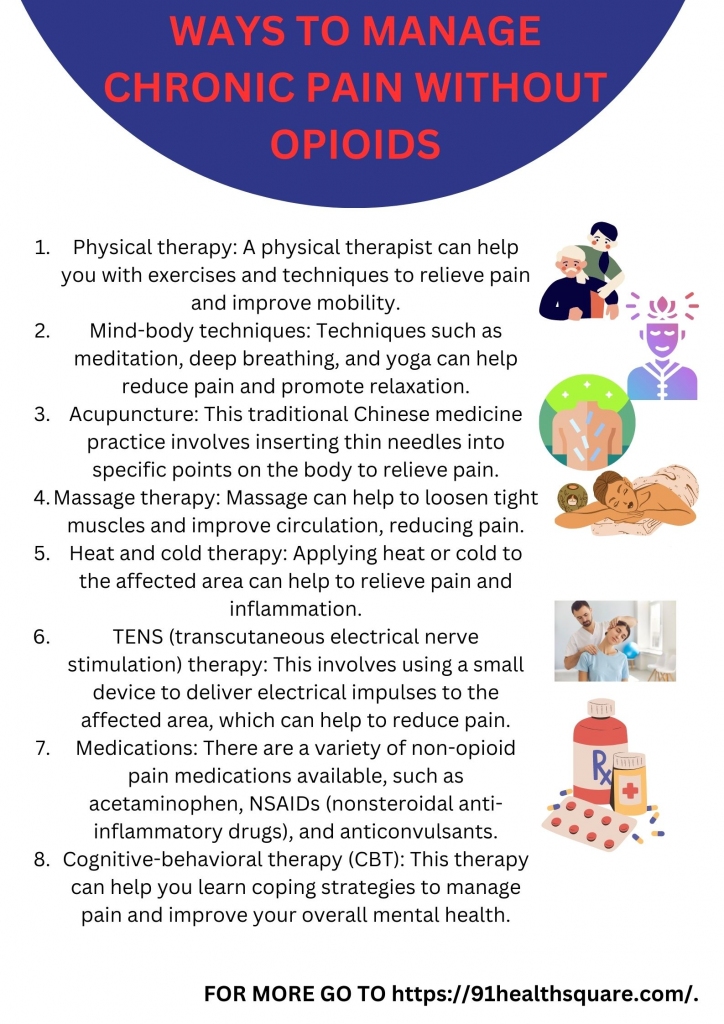103Views 0Comments

Chronic pain is a condition in which pain persists for longer than 3-6 months. It can be caused by a variety of factors, such as injury, illness, or nerve damage.
Chronic pain can have a significant impact on a person’s quality of life, including their ability to work, socialize, and engage in everyday activities. It can also have psychological effects, such as anxiety, depression, and decreased quality of life.
Diagnosing chronic pain can be challenging, as there is often no clear cause or underlying medical condition. A healthcare provider will typically conduct a physical exam, review your medical history, and
Chronic pain can be debilitating and affect a person’s quality of life, but there are ways to manage it without relying on opioids, which can be addictive and have side effects.
Treatment for chronic pain often involves a multi-disciplinary approach, combining different strategies to address the physical, psychological, and emotional aspects of pain. This may include medications, physical therapy, psychological counseling, and alternative therapies such as acupuncture or massage. The goal of treatment is to manage the pain and improve quality of life, while minimizing the risk of dependence on opioids or other medications.
why we should avoid opioids
Opioids are a class of drugs that are commonly used for pain relief, but they can have several harmful effects on the body. Here are some of the most significant harmful effects of opioids:
- Addiction: Opioids can be highly addictive and can lead to physical dependence, making it difficult for a person to stop using the drug. Over time, a person may require higher doses of the drug to achieve the same pain relief, leading to a dangerous cycle of addiction.
- Respiratory depression: Opioids can slow down breathing and can cause respiratory depression, which can be life-threatening. This is particularly dangerous if a person takes too high of a dose or mixes opioids with other drugs or alcohol.
- Constipation: Opioids can cause constipation, which can be severe and can lead to other complications such as bowel obstruction.
- Nausea and vomiting: Opioids can cause nausea and vomiting, particularly when a person first starts taking the drug or increases their dose.
- Drowsiness and confusion: Opioids can cause drowsiness and confusion, which can affect a person’s ability to work or perform other activities.
- Hormonal changes: Opioids can affect the production of hormones in the body, leading to a range of symptoms such as reduced libido, infertility, and decreased testosterone levels.
- Increased risk of falls and accidents: Opioids can affect a person’s coordination and balance, making them more likely to fall or have an accident.
- Overdose: Opioids can be deadly in high doses, particularly when combined with other drugs or alcohol. Overdose can cause respiratory failure and lead to death.
It’s important to note that not everyone who takes opioids will experience these harmful effects, and the risks can be mitigated through careful prescribing and monitoring. However, it’s crucial to be aware of the potential dangers of opioids and to use them only under the guidance of a healthcare provider.
common causes of chronic pain

Chronic pain can be caused by a variety of factors, including injury, illness, or an underlying medical condition. Here are some of the most common causes of chronic pain:
Musculoskeletal pain: This type of pain is related to the muscles, bones, tendons, and ligaments. It can be caused by injury, overuse, or conditions such as osteoarthritis, rheumatoid arthritis, or fibromyalgia.
Nerve damage: Nerve damage, also known as neuropathic pain, can be caused by conditions such as diabetes, multiple sclerosis, or shingles. It can also be caused by injury or surgery.
Headaches: Chronic headaches, such as migraines, can cause persistent pain and can be triggered by a variety of factors, including stress, hormonal changes, or certain foods.
Cancer: Cancer can cause chronic pain, either as a result of the cancer itself or as a side effect of treatment. Pain may be caused by the cancer itself or by treatment methods such as chemotherapy, radiation therapy, or surgery.
Inflammatory conditions: Chronic pain can be caused by conditions that cause inflammation in the body, such as rheumatoid arthritis, lupus, or inflammatory bowel disease.
Post-surgical pain: Pain after surgery can persist beyond the normal healing time and become chronic. This can be caused by nerve damage, scar tissue formation, or other factors.
Psychological factors: Chronic pain can also be influenced by psychological factors such as stress, anxiety, and depression. These factors can exacerbate pain and make it more difficult to manage.
It’s important to note that chronic pain can be complex and may involve a combination of factors. For example, someone with arthritis may also experience nerve damage, which can worsen their pain. Additionally, the experience of chronic pain is subjective and can vary from person to person. A healthcare provider will typically conduct a thorough evaluation to determine the cause of the pain and develop a treatment plan that is tailored to the individual’s specific needs.
strategies for managing chronic pain without opioids:

Physical therapy: Physical therapy is a type of treatment that uses exercises and manual techniques to help reduce pain and improve mobility. A physical therapist will work with you to develop a personalized plan that is tailored to your specific needs. This may include exercises to improve strength and flexibility, manual therapy techniques to reduce pain and stiffness, and education on how to maintain good posture and body mechanics.
Mind-body techniques: Mind-body techniques focus on the connection between the mind and body. These techniques can help reduce stress and anxiety, which can exacerbate chronic pain. Some examples of mind-body techniques include:
- Meditation: This involves focusing your attention on your breath or a specific object to help calm your mind and reduce stress.
- Deep breathing: This involves taking slow, deep breaths to help relax your body and reduce tension.
- Yoga: Yoga is a physical and mental practice that combines physical postures, breathing techniques, and meditation to improve flexibility, strength, and relaxation.
Acupuncture: Acupuncture is a traditional Chinese medicine practice that involves inserting thin needles into specific points on the body to relieve pain. It is believed that acupuncture helps to stimulate the body’s natural healing process and can improve circulation, reduce inflammation, and promote relaxation.
Massage therapy: Massage therapy involves the manipulation of muscles and soft tissues to reduce tension and relieve pain. Massage can help to loosen tight muscles and improve circulation, reducing pain.
Heat and cold therapy: Applying heat or cold to the affected area can help to relieve pain and inflammation. Heat therapy can be used to relax muscles, while cold therapy can help to reduce swelling and numb pain.
TENS therapy: TENS (transcutaneous electrical nerve stimulation) therapy involves using a small device to deliver electrical impulses to the affected area, which can help to reduce pain. The electrical impulses can help to disrupt pain signals to the brain and stimulate the release of endorphins, which are the body’s natural painkillers.
Medications: There are a variety of non-opioid pain medications available, such as acetaminophen, NSAIDs (nonsteroidal anti-inflammatory drugs), and anticonvulsants. These medications can help to reduce pain and inflammation.
Cognitive-behavioral therapy (CBT): CBT is a type of therapy that focuses on changing negative thought patterns and behaviors. CBT can help you learn coping strategies to manage pain and improve your overall mental health. This may include techniques such as relaxation training, cognitive restructuring, and problem-solving skills.
It’s important to note that everyone’s experience with chronic pain is different, and what works for one person may not work for another. It’s also important to work with your healthcare provider to develop a personalized treatment plan that takes into account your medical history, pain severity, and other factors. By taking a multi-disciplinary approach and combining different strategies, you can reduce your reliance on opioids and improve your quality of life.


